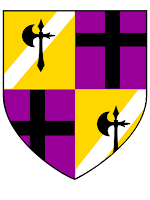As a fantasy writer, I have that unique problem of getting a bit lost in my own worlds. Sometimes I forget that I'm supposed to be writing a narrative and get lost in the colorful histories that happen in the background. This post is a perfect example. The Maric di Ascalon stories take place in a medieval world, one ruled by kings and other high lords. The sigils of these powerful families have always been a subject that interested me.
A few hours ago, I found a program that let me fiddle with and create my own coats-of-arms for these dynasties. Below, for the curious, are the emblems of the royal houses of the Northern Realms, as well as brief explanations as to their symbolism.
House Agrammar
Head: King Viktor IV
Sigil: A black dragon rampant upon a field of gold, bar sinister argent
Meaning: When Vidic Storm-Born, the younger son of the legendary hero Valten Gods-Hammer, led his people into the cold marches east of the Weather Hills after being exiled by his brother, Rodric Dwarf-Friend, he slew the black dragon, Visang, and built the fortress of Valdemar with its bones.
Motto: "Fiercer than flame."
House di Salianburg
Head: King Francis VII
Sigil: A golden lion rampant upon a teal field
Meaning: Because of his bloodline from the legendary Norvic king, Salian the Great, Francis I, the Duke of Salianburg, was elected by his peers, the Dukes of Merovech and Vermainz, to be king of the nation of Salianburg. The lion had been the symbol of the city of Salianburg since its founding and became House di Salianburg's crest.
Motto: "Dignity and courage."
House di Aquila
Head: King Richard II
Sigil: An argent eagle upon a field azure
Meaning: House di Aquila, hailing from the western counties of Osternmark, came to power as kings of the Middle Country when they succeeded the now-extinct House Dorset. The white eagle represents their proud heritage; they count Lantaean princes as their predecessors.
Motto: "Above all others."
House Angoth
Head: King Eamon I
Sigil: Three white swords upright on a field vert, bar sinister or
Meaning: Before the War of the Great Alliance, Eamon was a minor knight at the court of the previous Eaddic king, Tancred Thorgensen. After King Tancred was slain at Brennoc, Eamon led the fierce resistance against imperial rule in Eaddanwold. He was declared king by a council of Eaddic noblemen after the Battle of Hofstadt and adopted the sigil of the three swords, representing the three great battles he fought against the Lantaeans.
Motto: "By sword attested."
House Palatinus
Head: King Karlomann I
Sigil: A black axe on a field of gold, bar sinister argent, quartered with a black cross on a field purpure
Meaning: Karlomann is the son of King Quintinius Palatinus Martinian, who was the son of the exiled Lantaean prince, Martinus Palatinus Maximian. Despite his foreign parentage, Karlomann is half-Valting as well -- his mother was Princess Caroline vyr Gabrion, the only child of the king of Valtengrad. He combined the black axe upon gold of his mother's royal house with the colors of Lantaean nobility to signify his dual heritage.
Motto: "Honor unfailing."
House of Hrothmund
Head: King Ulfric Wolf-Born
Sigil: A pack of white wolves on a field sable, bar argent
Meaning: The kingship of Nordengard is largely symbolic. In truth, each jarl rules his land as a petty king, but all pay homage to the king they choose by moot. All jarls claim lineage to Hrothmund the Greybeard. Every king who has ruled Nordengard has ruled with his own crest, rather than adopting the sigil of their predecessor. Ulfric's sigil is that of a pack of wolves, symbolizing the camaraderie and blood-bonds between shield-siblings in his longhall.
Motto: "Vigilance and duty."
House di Lancastre
Head: Duke Guy di Lancastre, the Duke of Merovech, the Count of Merovar
Sigil: Three black lilies on a field of scarlet, golden cross
Meaning: The three lilies symbolize the great honors conferred upon their house by the king. The scarlet is for the warrior blood that flows in all the sons of their house and the golden cross was added by Guy di Lancastre, to represent the time he spent among the Paladin Court in Pellanmere.
Motto: "In war, victory."
*Note: While House di Lancastre is not a royal house, it is one of the most influential families in the Northern Realms. After the death of Prince Louis di Salianburg, the only son of King Francis VII, Guy di Lancastre is the most worthy candidate for the throne.









Great tips, I like the guidelines you've laid out here...helpful!
ReplyDelete